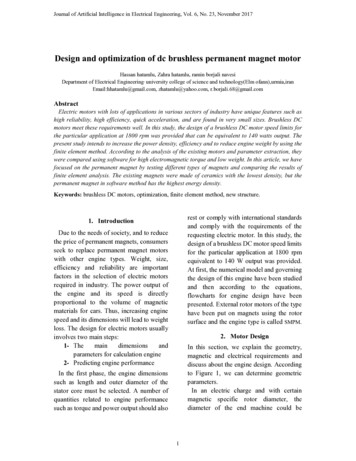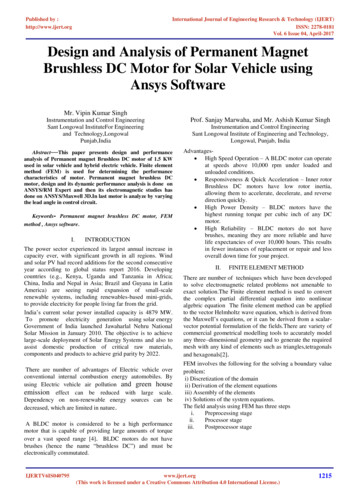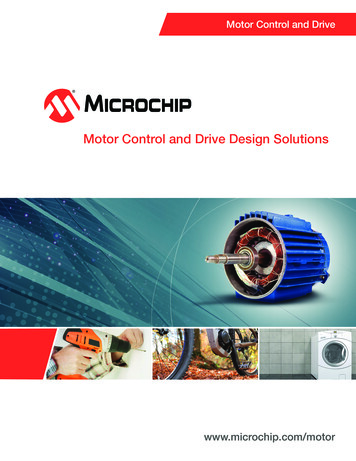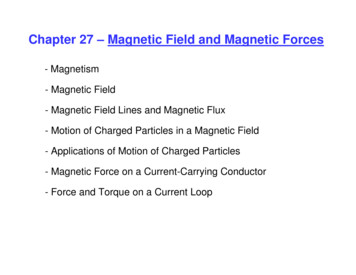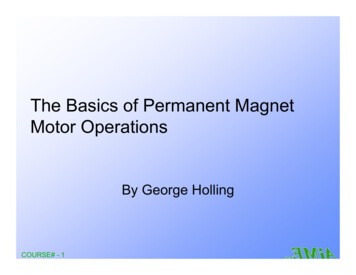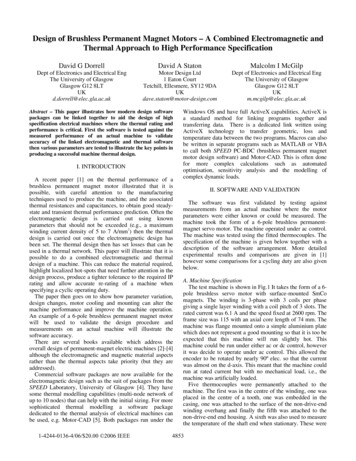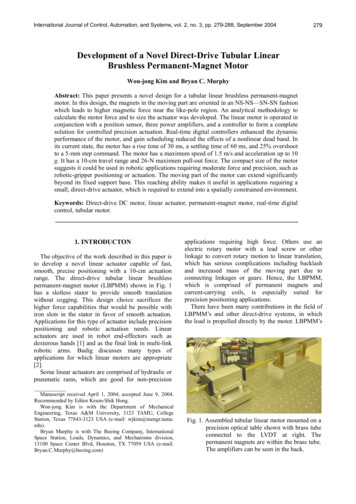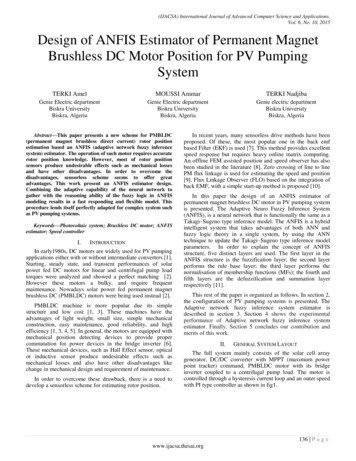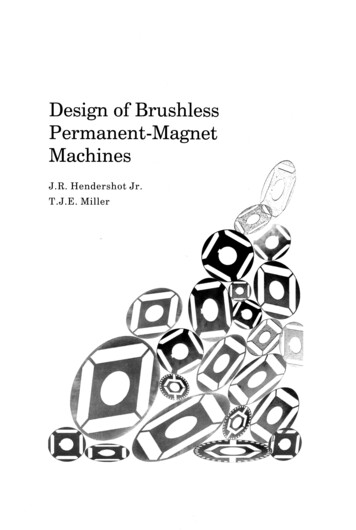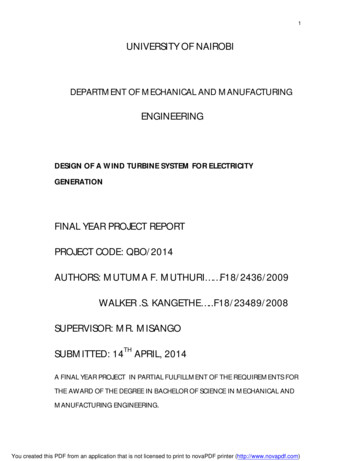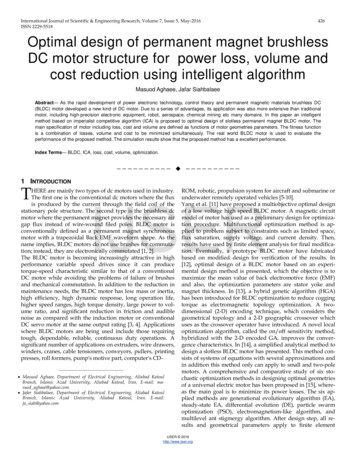
Transcription
International Journal of Scientific & Engineering Research, Volume 7, Issue 5, May-2016ISSN 2229-5518426Optimal design of permanent magnet brushlessDC motor structure for power loss, volume andcost reduction using intelligent algorithmMasuod Aghaee, Jafar SiahbalaeeAbstract— As the rapid development of power electronic technology, control theory and permanent magnetic materials brushless DC(BLDC) motor developed a new kind of DC motor. Due to a series of advantages, its application was also more extensive than traditionalmotor, including high-precision electronic equipment, robot, aerospace, chemical mining etc many domains. In this paper an intelligentmethod based on imperialist competitive algorithm (ICA) is proposed to optimal design of slotless permanent magnet BLDC motor. Themain specification of motor including loss, cost and volume are defined as functions of motor geometries parameters. The fitness functionis a combination of losses, volume and cost to be minimized simultaneously. The real world BLDC motor is used to evaluate theperformance of the proposed method. The simulation results show that the proposed method has a excellent performance.Index Terms— BLDC, ICA, loss, cost, volume, optimization.—————————— ——————————1 INTRODUCTIONTHERE are mainly two types of dc motors used in industry.The first one is the conventional dc motors where the fluxis produced by the current through the field coil of thestationary pole structure. The second type is the brushless dcmotor where the permanent magnet provides the necessary airgap flux instead of wire-wound filed poles. BLDC motor isconventionally defined as a permanent magnet synchronousmotor with a trapezoidal Back EMF waveform shape. As thename implies, BLDC motors do not use brushes for commutation; instead, they are electronically commutated [1, 2].The BLDC motor is becoming increasingly attractive in highperformance variable speed drives since it can producetorque-speed characteristic similar to that of a conventionalDC motor while avoiding the problems of failure of brushesand mechanical commutation. In addition to the reduction inmaintenance needs, the BLDC motor has low mass or inertia,high efficiency, high dynamic response, long operation life,higher speed ranges, high torque density, large power to volume ratio, and significant reduction in friction and audiblenoise as compared with the induction motor or conventionalDC servo motor at the same output rating [3, 4]. Applicationswhere BLDC motors are being used include those requiringtough, dependable, reliable, continuous duty operations. Asignificant number of applications on extruders, wire drawers,winders, cranes, cable tensioners, conveyors, pullers, printingpresses, roll formers, pump's motive part, computer's CD-ROM, robotic, propulsion system for aircraft and submarine orunderwater remotely operated vehicles [5-10].Yang et al. [11] have proposed a multiobjective optimal designof a low voltage high speed BLDC motor. A magnetic circuitmodel of motor has used as a preliminary design for optimization procedure. Multifunctional optimization method is applied to problem subject to constraints such as limited space,flux saturation, supply voltage, and current density. Then,results have used by finite element analysis for final modification. Eventually, a prototype BLDC motor have fabricatedbased on modified design for verification of the results. In[12], optimal design of a BLDC motor based on an experimental design method is presented, which the objective is tomaximize the mean value of back electromotive force (EMF)and also, the optimization parameters are stator yoke andmagnet thickness. In [13], a hybrid genetic algorithm (HGA)has been introduced for BLDC optimization to reduce coggingtorque as electromagnetic topology optimization. A twodimensional (2-D) encoding technique, which considers thegeometrical topology and a 2-D geographic crossover whichuses as the crossover operator have introduced. A novel localoptimization algorithm, called the on/off sensitivity method,hybridized with the 2-D encoded GA, improves the convergence characteristics. In [14], a simplified analytical method todesign a slotless BLDC motor has presented. This method consists of systems of equations with several approximations andin addition this method only can apply to small and two-polemotors. A comprehensive and comparative study of six stochastic optimization methods in designing optimal geometriesof a universal electric motor has been proposed in [15], whereas the main goal is to minimize its power losses. The six applied methods are generational evolutionary algorithm (EA),steady-state EA, differential evolution (DE), particle swarmoptimization (PSO), electromagnetism-like algorithm, andmultilevel ant stigmergy algorithm. After design step, all results and geometrical parameters apply to finite �——— Masuod Aghaee, Department of Electrical Engineering, Aliabad KatoulBranch, Islamic Azad University, Aliabad Katoul, Iran. E-mail: masuod aghaee@yahoo.com Jafar Siahbalaee, Department of Electrical Engineering, Aliabad KatoulBranch, Islamic Azad University, Aliabad Katoul, Iran. E-mail:ja siah@yahoo.comIJSER 2016http://www.ijser.org
International Journal of Scientific & Engineering Research, Volume 7, Issue 5, May-2016ISSN 2229-5518method and power losses of all designs are evaluated andcompared to each other. Jang et al. [16] have used an analyticalmethod to design and analysis of a high speed and high power density BLDC motor for centrifugal compressor. Then, theelectromagnetic field, back EMF, and power losses are analyzed and the results are validated by finite element method.After that, the test machine has been manufactured and usedfor experimental tested for confirmation of the method. In [17],a detailed and comprehensive formulations necessity andneeded in design of slotless BLDC motors with surfacemounted magnet configuration have been presented considering both torque and speed as mechanical requirements. Then,GA has been used to find the optimal geometries of the motor.An objective function has been proposed covering the losses,cost and volume of the motor besides the mechanical and electrical requirements and constraints. In [18], a design methodfor a small-sized slotless BLDC motor with distributed hexagonal windings has employed and the objective is maximizingtorque density. This new design method is semi-analyticalwhereas, numerical approaches based on finite element analysis with an analytic model are used to analyze the magneticand output characteristics of the motor. The designed motor isfabricated, and the experimental results are compared with theresults of the simulation. An analytical magnetic field distribution for slotless brushless machines with inset permanentmagnets is presented in [19-21]. The induced backelectromotive force (EMF) is also presented for each magnetization pattern. The effects of iron inter-pole on the magneticflux density and back-EMF have been considered. To verifythe model, the results have been compared with finite elementanalyses results. In [22], a method for motor magnets design isproposed to optimize a BLDC motor based on design of experiment (DOE) method in order to reduce the cogging torque.The DOE methodology is used for a screening of the designspace and for the generation of approximation models usingresponse surface techniques. The experiments were performedbased on the response surface methodology, as a statisticaldesign of experiment approach, in order to investigate theeffect of parameters on the response variations.In most of the reviewed papers, the effect of required speedhas been neglected in the optimization procedure and therefore power of the BLDC motor is not well defined. In this paper, a method for the optimal design of a slotless permanentmagnet BLDC motor with surface mounted magnets using aICA has been presented considering torque, maximum speed,voltage, losses and cost. An objective function has been proposed covering the power losses, material cost and volume ofthe motor simultaneously, besides the mechanical and electrical requirements. All of the effective parameters and constantshave been considered in the optimization problem. ICA beenused to find the optimal geometries of the assumed motor.Electrical and mechanical requirements such as voltage,torque and speed and other limitations e.g. upper and lowerlimits of the motor geometries are cast into constraints of theoptimization problem. The results have been examined usingsensitivity analysis and showed the efficacy of the proposedtechnique.4272 SLOTLESS BLDC MOTOR STRUCTUREThe BLDC motors are categorized into two major groups fromstator structure point of view; slotted and slotless. The preliminary BLDC motors have designed with slotted stator butnewest ones have slotless configuration and the windings arewound into a cylindrical shape on the surface of the stator andare encapsulated in a high-temperature epoxy resin to maintain their orientation with respect to the stator laminations.Instead, the rotor is similar to that used in the conventionalslotted BLDC motor. It has a number of magnet segments thatdefine the motor poles and are affixed to a rotor core centeredabout and fixed to the motor shaft. The magnets are usually ahigh strength, rare-earth type, such as neodymium iron boronor samarium cobalt [23].The preliminary advantage to be explored with the use of aslotless machine design is the reduction in manufacturingcosts and its simplicity in production, compared to the manufacturing costs of a slotted BLDC machine. The production of alaminated stator is an expensive process, with steel laminations cut out from steel sheets, and these laminations are normally manually stacked together and affix. There also tends tobe some material waste in this process, as there are an integernumber of laminations that can be cut from a single sheet ofsteel. The slotless stator design originated with the goal to deliver smooth running performance and eliminate cogging andreduce slot harmonic effect. Mainly, the absence of coggingtorque is the frequently cited reason for selecting a slotlessBLDC motor. In order to minimize cogging torque in slottedconfiguration motors, techniques such as skewed stator slotsor fractional slots can be employed and this makes designmore complex and expensive. In addition, iron loss in aslotless motor is less than in an equivalent slotted design, inherently. Also, low magnetic saturation allows the motor tooperate at several times its rated power for short intervalswithout perceptible torque roll-off at higher power levels.Several advantages of slotless BLDC are as follows, lightweight, submersible, low winding inductance, high speed capability, lower vibration, lower audible noise, fast current response, high reliability, low electrical resistance, low staticfriction, Operates in hostile environment and no sparking, andhigh thermal efficiency [14, 18, 24].The slotless BLDC motor mainly use as medical devices andfactory automation, such as high speed medical drills, surgicalrobot systems, prosthetic limb drive systems, high speed miniature spindles, and etc [25- 28].IJSER3 IMPERIALIST COMPETITIVE ALGORITHM (ICA)ICA is a population-based stochastic search algorithm. It hasbeen introduced by Atashpaz and Lucas [29, 30]. Since then, itis used to solve some kinds of optimization problem. The algorithm is inspired by imperialistic competition. It attempts topresent the social policy of imperialisms to control more countries and use their sources when colonies are dominated bysome rules. If one empire loses its power, the rest of them willcompete to take its possession. In ICA, this process is simulated by individuals that are known as countries.This algorithm starts with a randomly initial population andIJSER 2016http://www.ijser.org
International Journal of Scientific & Engineering Research, Volume 7, Issue 5, May-2016ISSN 2229-5518objective function which is computed for them. The mostpowerful countries are selected as imperialists and the othersare colonies of these imperialists .Then the competition between imperialists take place to get more colonies .The bestimperialist has more chance to possess more colonies. Thenone imperialist with its colonies makes an empire. Figure 1shows the initial populations of each empire. If the empire isbigger, its colonies are greater and the weaker ones are less. Inthis figure Imperialist 1 is the most powerful and has thegreatest number of colonies.After dividing colonies between imperialists, these coloniesapproach their related imperialist countries. Figure 2 represents this movement. Based on this concept each colony movestoward the imperialist by a units and reaches its new position.Where a is a random variable with uniform (or any proper)distribution, b, a number greater than 1, causes colonies movetoward their imperialists from different direction and S is thedistance between colony and imperialist.α U (0, β S )(1)428than its relevant imperialist, they will exchange their positions. To begin the competition between empires, total objective function of each empire should be calculated. It dependson objective function of both an imperialist and its colonies.Then the competition starts, the weakest empire loses its possession and powerful ones try to gain it. The empire that haslost all its colonies will collapse. At last the most powerfulempire will take the possession of other empires and wins thecompetition [29, 30].To apply the ICA for clustering, the following steps have to betaken:Step 1: The initial population for each empire should be generated randomly.Step 2: Move the colonies toward their relevant imperialist.Step 3: Exchange the position of a colony and the imperialist ifits cost is lower.Step 4: Compute the objective function of all empires.Step 5: Pick the weakest colony and give it to one of the bestempires.Step 6: Eliminate the powerless empires.Step 7: If there is just one empire, stop, if not go to 2.The last Imperialist is the solution of the problem.IJSER4 SIMULATION RESULTS AND DISCUSSIONS4.1 Optimization ProcedureThe main stage in the optimization of BLDC motor design ischoosing objective function and setting constraints. First, theoptimization variables, i.e. those motor parameters that needto be optimally found, should be represented as a vector, x:x [ p β l m l y lw l g rr l Ac J cu ]T(2)The form of a proper objective function depends on the application and the required quantity of the motor. In this study theobjective function consists of losses, cost and volume (mass)all of which should be minimized simultaneously. Threeweighting factors are considered in order to bring all the objectives in a comparable scale and to control the importance ofeach individual objective. Therefore the objective function iswritten as:Fig. 1. Generating the initial empiref 0 (x ) w V V t (x ) w P Ptotal (x ) w C C (x )(3)Where, wP, wV and wC are weighting factors, Ptotal is totalpower loss of motor, and C is the total cost of the materialsused in the motor design. To solve the optimization problemone needs to initialize the constant parameters of the motorand the optimization technique parameters, see Table 1 andTable 2.The upper and lower limits of the optimization variables andtheir obtained optimum values after optimization are listed inTable 3. Other characteristics of the optimized motor are listedin Table 4.Fig. 2. Moving colonies toward their relevant ImperialistIf after this movement one of the colonies possess more powerIJSER 2016http://www.ijser.orgTABLE 1LIST OF CONSTANT PARAMETERS AND THEIR VALUES
International Journal of Scientific & Engineering Research, Volume 7, Issue 5, May-2016ISSN 2229-5518kfkckskrδB r (T )B syknee (T )κ (A 2 m 3 )wp0.70.6660.951511.5ρ m (kg m -3 )ρw (kg m -3 )ρ y (kg m -3 )c m 1 (ℑ kg -1 )c m 2 (ℑ)11101.92anγc 2 (ℑ kg )T em* (Nm )-11157140w r* (rad s -1 )V * (v )TABLE CHARACTERISTICS OF THE OPTIMIZED MOTOR.TABLE 2COEFFICIENT VALUES IN THE 4.4115Pe2.4500Pb2.1195Pw0.0783N pop50W vV t0.7891N impγ12W cC0.82050.40.1W p Pl1.0248W vV t W cC W p Pl2.6345ζβ20IJSERMax iteration.fo100EfficiencyTABLE 3StandardOPTIMIZATION 0010.004rr0.0050.1ls0.0060.6933Ac0.12J cu3 1066 1061V (Volt)I (Ampere)0.69122.590.9661 0.041.3034 e 05920.07301.99515.8198 e 06The variation of each optimization parameters during ICArun is shown in Fig. 3. It can be observed that after 200 iterations, all the parameters are stables and reach to their optimum value. Therefore, it is shown that the ICA has a goodspeed for convergence. This fact can be seen from Fig. 4. Thisfigure has shown the "Eligibility Criteria" in 5 different runs.In addition, it can be found that the proposed optimizationprocedure is stable and can solved the optimization problemsatisfactory and without computational burden in each run.4.2 Effects of the parameters of the ICA on theperformance of the methodIn this subsection we have analyzed the sensitivity of the proposedmethod with respect to the N imp , N pop , β , and γ , which con-ξtrol the behavior, and thus, the goodness of the ICA search process.The achieved results for 10 set of parameters are shown in Table 5.The average of best obtained value is depicted in table. It illustratesthat this hybrid system have a little dependency on variation of theparameters.IJSER 2016http://www.ijser.org
International Journal of Scientific & Engineering Research, Volume 7, Issue 5, May-2016ISSN 2229-55184304.3 Comparison with genetic algorithmIn order to compare the performance of ICA with another natureinspired algorithms, we have used genetic algorithm (GA) [17], toevolve the proposed method. According to results in Tables 6 and 7,the best performance obtained by ICA is 2.59. It can be seen that thesuccess rates of ICA is higher than the performance of GA [17].TABLE 6OPTIMIZATION VARIABLESFig 3. Variation of each optimization parameters during ICA 0.1ls0.0060.6933Ac0.12J cu3 1066 1060.0060.00352.75run 1run 2run 3run 4run 3504004505000.0010.05950.075625800000Fig 4. Eligibility Criteria in 5 different runs5 CONCLUSIONTABLE 5PERFORMANCE OF PROPOSED METHOD (ICA-BLDC) FORDIFFERENT VALUES OF PARAMETERSN 5In this paper a new technique for the design optimization of slotlessBLDC motors with surface magnet structure has been presented considering torque, maximum speed, voltage, losses and cost. An objective function has been proposed covering the power losses, materialcost and volume of the motor besides the mechanical and electricalrequirements. This method is based on capability of populationbased optimization algorithms in finding the optimal solution. Forthis purpose we have considered GA and ICA. Unlike the GA, theICA has no complicated evolutionary operators such as crossover,roulette wheel and mutation. After the design optimization of a givenslotless BLDC motor using optimization algorithms, some conclusions can be drawn.As well known, both exploration and exploitation are necessary forthe population-based optimization algorithms. In practice, the exploration and exploitation contradict with each other, and in order toachieve good optimization performance, the two abilities should bewell balanced. The superior performance of the ICA is due to itsability to simultaneously refine a local search, while still searchingglobally. It can do this because of the information exchange betweenthe top eggs and the exploration globally due to the abandoning ofnests and search via Immigration. Second, simulation results illustrate that ICA have a little dependency on variation of the parameIJSER 2016http://www.ijser.org
International Journal of Scientific & Engineering Research, Volume 7, Issue 5, May-2016431ISSN 2229-5518ters. Third concerning the computational efforts, ICA was very fast, [6] J.E. MuraliDhar, P. Varanasi. A Progressive Rugged Appearance of FuzzyController Fed Four-switch BLDC Drive . Procedia Computer Science, Volrequiring a few seconds to find the optimum. The results have beenume 47, 2015, Pages 144-152analyzed and showed the efficacy of the proposed technique for de[7] Mehdi Salehifar, Manuel Moreno-Equilaz. Fault diagnosis and faultsign of electrical machineries.tolerant finite control set-model predictive control of a multiphase voltagesource inverter supplying BLDC motor. ISA Transactions, Volume 11, 2015,TABLE 7Pages 101-112.COMPARISON BETWEEN ICA AND GA[8] Agus Purwadi, Jimmy Dozeno, Nana Heryana. Testing Performance of 10kW BLDC Motor and LiFePO4 Battery on ITB-1 Electric Car Prototype.Is ICAProcedia Technology, Volume 11, 2013, Pages 1074-1082[9] Jose Luis Romeral Martinez, Ramin Salehi Arashloo, Mehdi Salehifar, JuanbetterManuel Moreno. Predictive current control of outer-rotor five-phase BLDCgenerators applicable for off-shore wind power plants. Electric Power SysGAICAParameterstems Research, Volume 121, April 2015, Pages 260-269than[10] K. Premkumara, B.V. Manikandan. Speed control of Brushless DC motorusing bat algorithm optimized Adaptive Neuro-Fuzzy Inference System.GA?Applied Soft Computing 32 (2015) 403–419.[11] Y. P. Yang, and T. C. Chiao, Multiobjective optimal design of a high speed0.00164 brushless DC motor, Electric Machines and Power Systems, Vol. 28, 2000,0.0011Vtpp. 13-30.[12] S. Vivier, F. Gillon, P. Brochet, Optimization techniques derived from ex56.71 51.2446Ptotalperimental design method and their application to the design of a brushlessdirect current motor, IEEE Transactions on Magnetics, Vol. 37, No. 5, 2001,44.81 42.1851pp. 3622-3626.Pcu[13] C. H. Im, H. K. Jung, and Y. J. Kim, Hybrid Genetic Algorithm for Electromagnetic Topology Optimization, IEEE Transactions on Magnetics, Vol. 39,6.18 4.4115PhNo. 5, 2003, pp. 2163-2169.[14] M. Markovic, and Y. Perriard, Simplified design methodology for a slotless3.52 2.4500brushless DC motor, IEEE Transactions on Magnetics, Vol. 42, No. 12, 2006,Pepp. 3842-3846.2.12 2.1195[15] T. Tusar, P. Korosec, G. Papa, B. Filipic, and J. Silc, A comparative study ofPbstochastic optimization methods in electric motor design, Applied Intelligence, Vol. 27, No. 2, 2007, pp. 101-111.0.08 0.0783Pw[16] S. M. Jang, H. W. Cho, and S. K. Choi, Design and Analysis of a High-SpeedBrushless DC Motor for Centrifugal Compressor, IEEE Transactions on0.776 0.7891Magnetics, Vol. 43, No. 6, 2007, pp. 2573-2575.W vV t[17] A. Rahideh, T. Korakianitis, P. Ruiz, T. Keeble, and M. T. Rothman, Opti0.861 0.8205mal brushless DC motor design using genetic algorithms, Journal of MagW cCnetism and Magnetic Materials, Vol. 322, 2010, pp. 3680-3687.[18] J. M. Seo, J. H. Kim, I. S. Jung, and H. K. Jung, Design and Analysis of1.136 1.0248W p PlSlotless Brushless DC Motor, IEEE Transactions on Industry Applications,Vol. 47, No. 2, 2011, pp. 730-735.2.773 2.6345[19] A. Rahideh, and T. Korakianitis, Analytical Magnetic Field Distribution ofW vV t W cC W p PlSlotless Brushless Machines With Inset Permanent Magnets, IEEE Transac2.78 tions on Magnetics, Vol. 47, No. 6, 2011, pp. 1763-1774.2.59fo[20] A. Rahideh, and T. Korakianitis, Analytical Armature Reaction Field Distribution of Slotless Brushless Machines with Inset Permanent Magnets, IEEETransactions on Magnetics, Vol. 48, No. 7, 2012, pp. 2178-2191.[21] A. Rahideh, and T. Korakianitis, Analytical calculation of open-circuit magREFERENCESnetic field distribution of slotless brushless PM machines, Electrical Powerand Energy Systems, Vol. 44, 2013, pp. 99-114.[1] Mohamed S. Zaky. A self-tuning PI controller for the speed control of[22] K. Abbaszadeh, F. R. Alam, and S. A. Saied, Cogging torque optimizationelectrical motordrives. Electric Power Systems Research 119 (2015) 293–303in surface-mounted permanent-magnet motors by using design of experi[2] K. Premkumar a,n, B.V.Manikandan. Adaptive Neuro-Fuzzy Inferencement, Energy Conversion and Management, Vol. 52, 2011, pp. 3075-3082.System based speed controller for brushless DC motor. Neurocomputing[23] J. R. Hendershot, and T. J. E. Miller, Design of Brushless Permanent-Magnet138 (2014)260–270Machines, Motor Design Books LLC, USA, 1994.[3] H.E.A. Ibrahim. Optimal PID control of a brushless DC motor using PSO[24]S.H. Lai, Design Optimisation of a Slotless Brushless Permanent Magnetand BF techniques. Ain Shams Engineering Journal (2014) 5, 391–398.DC Motor with Helically-Wound Laminations for Underwater Rim-Driven[4] Alireza Shabanian, Armin Amini Poustchi Tousiwas, Massoud Pourmandi,Thrusters, Ph.D. Thesis, University of Southampton, England, 2006.Aminollah Khormali, Abdolhay Ataei. Optimization of brushless directcurrent motor design using an intelligent technique .ISA Transactions, Vol- [25] F. I. Al-Naemi, and A. J. Moses, FEM modeling of rotor losses in PM motors, Journal of Magnetism and Magnetic Materials, Vol. 304, 2006, pp.794ume 57, July 2015, Pages 311-321.797.[5] Ramin Salehi Arashloo, Mehdi Salehifar, Luis Romeral, Vicent Sala. A robust predictive current controller for healthy and open-circuit faulty condi- [26] Z. Q. Zhu, and D. Howe, Instantaneous magnetic field distribution inbrushless permanent magnet DC motors, part II: armature-reaction field,tions of five-phase BLDC drives applicable for wind generators and electricIEEE Transactions on Magnetics, Vol. 29, No. 1, 1993, pp. 136-142.vehicles. Energy Conversion and Management, Volume 92, 1 March 2015,[27] J. Saari, Thermal analysis of high speed induction machines, Ph.D. Thesis,Pages 437-447Helsinki University of Technology, Finland, 1998.IJSERIJSER 2016http://www.ijser.org
International Journal of Scientific & Engineering Research, Volume 7, Issue 5, May-2016ISSN 2229-5518[28] Z. Q. Zhu, D. Howe, E. Bolte, and B. Ackermann, Instantaneous magneticfield distribution in brushless permanent magnet DC motors, part I: opencircuit field, IEEE Transactions on Magnetics, Vol. 29, No. 1, 1993, pp. 124135.[29] E. Atashpaz-Gargari, C. Lucas. Imperialist competitive algorithm: an algorithm for optimization inspired by imperialistic competition. In: Proceedings of the IEEE Congress on Evolutionary Computation, Singapore 2007;4661–4667[30] Zaniar Ardalan, Sajad Karimi, Omid Poursabzi, B. Naderi. A novel imperialist competitive algorithm for generalized traveling salesman problems.Applied Soft Computing, Volume 26, January 2015, Pages 546-555IJSERIJSER 2016http://www.ijser.org432
Optimal design of permanent magnet brushless DC motor structure for power loss, volume and cost reduction using intelligent algorithm . Masuod Aghaee, Jafar Siahbalaee . Abstract— As the rapid development of power electronic technology, control theory and permanent magnetic materials brushless DC (BLDC) motor
